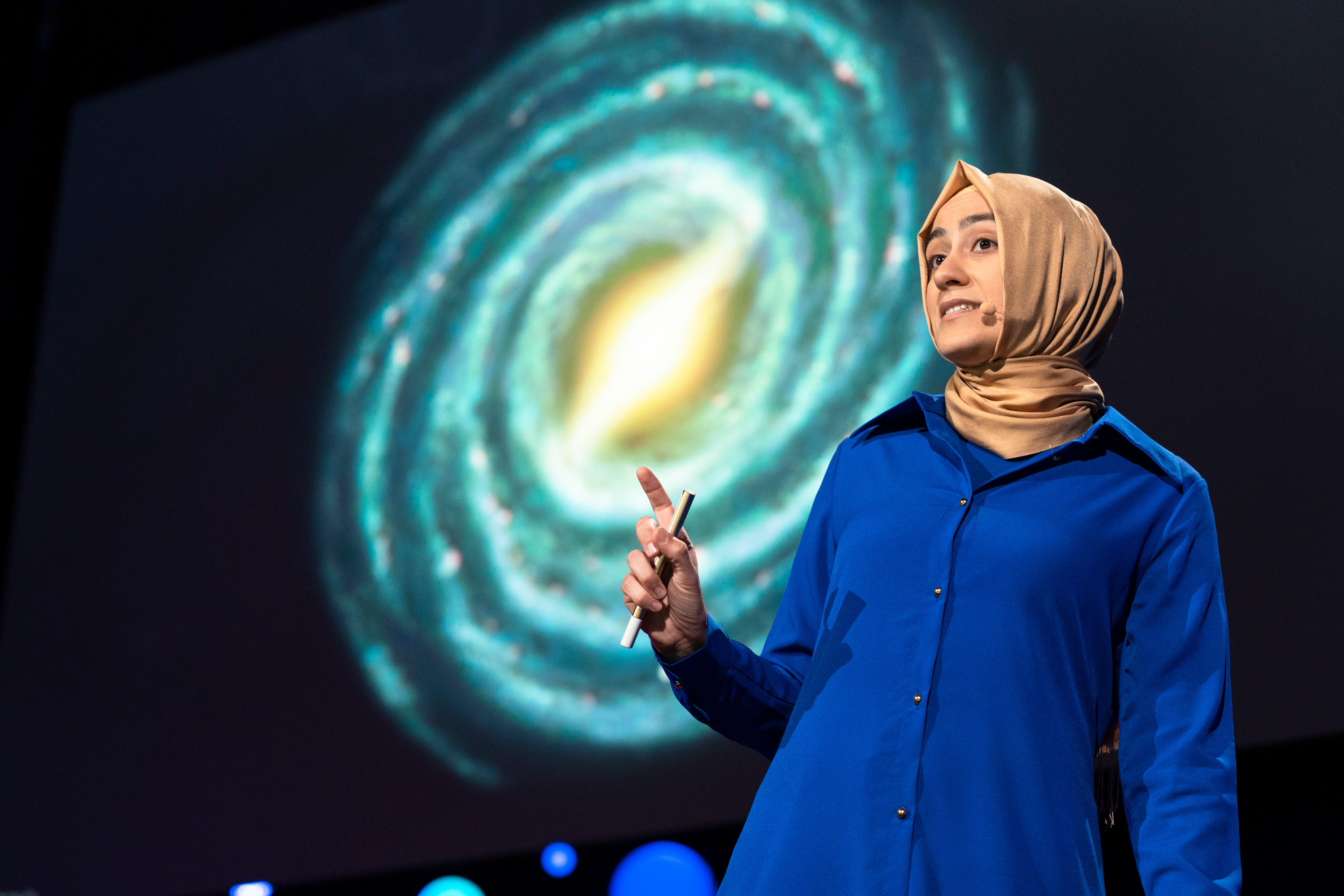
So, what’s it like to discover a rare galaxy? Burçin Mutlu-Pakdil speaks about her singular experiences during Fellows Session 1 at TED2018: The Age of Amazement, April 10, 2018, in Vancouver. Photo: Ryan Lash /TED
Forget those miserly folk who hoard their best for the last — TED believes in starting strong. Kicking off TED2018 is Session 1 of the TED Fellows, who count among their ranks artists, activists, scientists, researchers, conservationists, thinkers and changemakers of all kinds. The Fellows program now total 453 individuals from 96 countries. In this session, the 10 newest Fellows, and 4 Senior Fellows, took the stage in the Community Theater.
TED Senior Fellow Joshua Roman begins the session with his original composition “Riding Light.” It’s a tossup as to what is more compelling: His music, which ranges from challenging to melodic to rhythmic? Or his bright argyle socks? Answer: All of the above! (Session attendees check off “listen to shoeless cellist” from their bucket list.)
Our planet’s last wild places: breathtaking and at risk. We humans are fundamentally connected to and dependent on the natural world, but our stewardship of it has been, frankly speaking, lousy. Four years ago, it was declared that half of the planet’s wildlife had disappeared in just 40 years. “We urgently need to create safe spaces for these wild animals,” says explorer and conservation biologist Steve Boyes, a TED Senior Fellow. In 2014, Boyes and his colleagues launched an effort to explore and protect southern Africa’s Okavango Delta, the largest undeveloped river basin in the world. Navigating territorial hippos and incendiary landmines in dugout canoes, they explored and conducted detailed scientific surveys of all of the major rivers in the basin. A group of 57 scientists is also exploring an area called the Okavango-Zambezi Water Tower, and they’re currently working to establish a government system to preserve it. Boyes urges us all to act now — not a few months from now or a few years from now, but now now — to preserve the earth’s remaining wild spaces. “Preserving wilderness is far more than simply protecting ecosystems that clean the water we drink and create the air we breathe,” he says. “Preserving wilderness protects our basic human right to be wild, our basic human right to explore.”
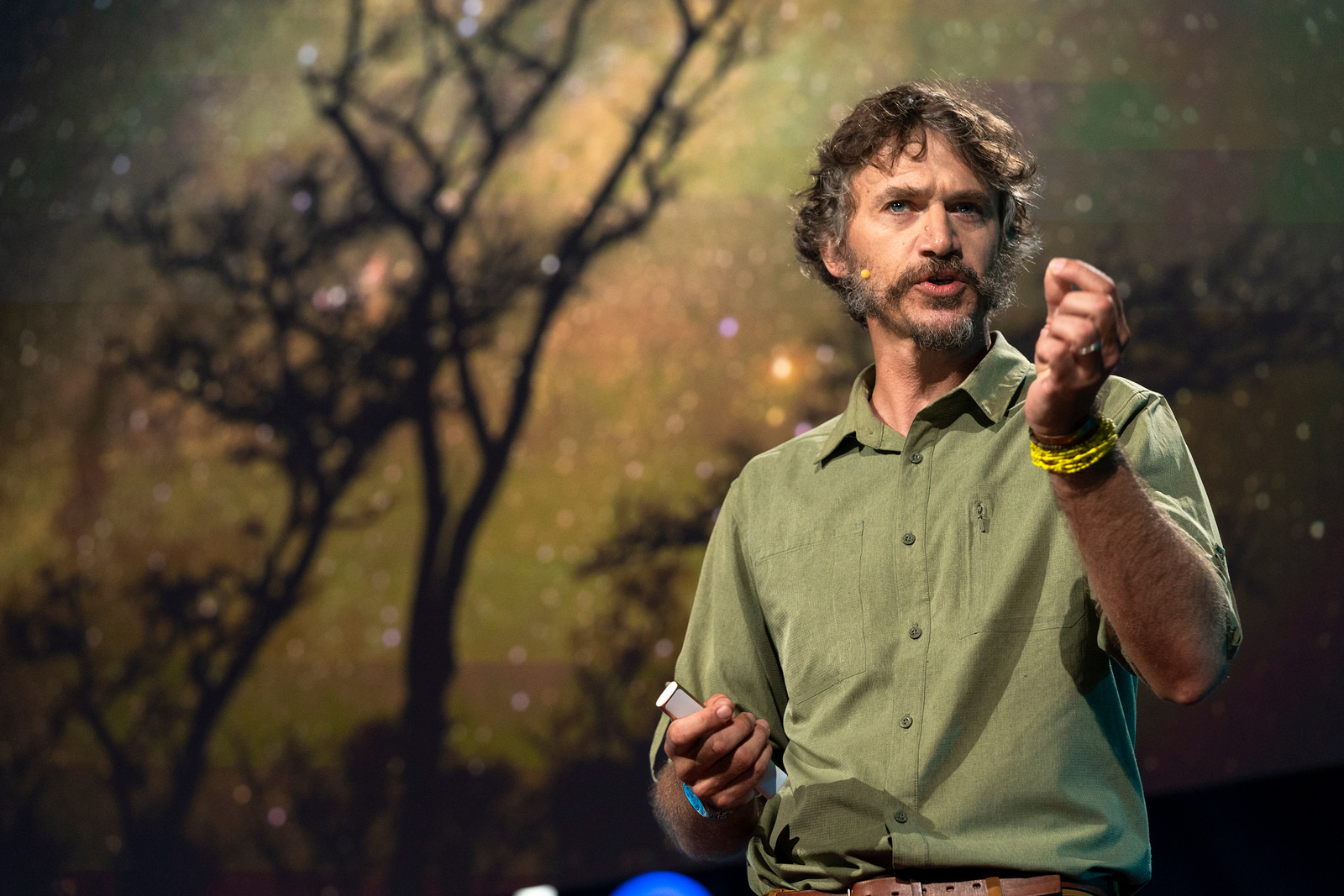
In a passionate talk, conservation activist Steve Boyes makes the case to preserve wild spaces — not just for the wild animals and plants that live there, but for humanity’s sake too. Photo: Ryan Lash / TED
In a puzzling galaxy far, far away … As far as we know, the universe houses more than one trillion galaxies, and most of them take the form of spirals like our own Milky Way. However, there are other kinds and shapes of galaxies, and scientists are still trying to grasp how they form and evolve. Hoag-type galaxies — symmetrical circular rings with nothing visibly connecting them — were believed to be the most uncommon type … until University of Arizona astrophysicist Burçin Mutlu-Pakdil and her team discovered the rarest celestial event they’d ever seen. Now named Burçin’s Galaxy, it was first thought to be a Hoag-type galaxy until close study revealed it to have an outer ring and a reddish second inner ring. “There is no known mechanism that can explain the existence of an inner ring in such a peculiar system,” Mutlu-Pakdil says. “Discovery of such rare galaxies tells us that we still have a lot to learn, and we should keep looking deeper and deeper in space and search for the unknown.” (Okay, a new item to add to bucket list: “discover galaxy and have it named after you.”)
Promoting civilian-centered security. Nearly two decades have passed since 9/11, and in its wake, countless policies have been written and implemented, ostensibly designed to bolster security. But have the policies actually made us more secure? No, according to international security researcher Benedetta Berti, a TED Senior Fellow. Too often, officials see global security as a zero-sum game, and that the only way to become safer is by compromising on human values and rights. “This narrative is flawed and, worse, counterproductive,” says Berti, fueling a never-ending cycle of conflict, trauma and radicalization. The alternative she proposes: shift away from a military-first approach and toward a sustainable focus on protecting civilians and building lasting peace. By shielding everyone from violence and ensuring that their lives can be lived in dignity, Berti says, we can succeed in creating a stable future for all.
Empowering and educating people to stop fake news. “Fake news is not only bad for journalism,” says Ukrainian editor Olga Yurkova, “it’s a threat for democracy and society.” In 2014, she and a group of journalists launched a website called StopFake.org, which investigates and exposes biased, inaccurate reporting about the Ukraine. Since its launch, StopFake has taught more than 10,000 people how to spot fake news and trained fact-checkers around the world. There are two easy ways we can all make sure we’re not reading (or sharing) untruth, according to Yurkova. First, be skeptical when you come across a story that is exceptionally dramatic, captivating or clickbait-y; the truth is often not that exciting. Second, don’t simply accept what you read; double-check the facts by consulting other sites and Googling names, addresses and authors. After all, “our society depends on trust — trust in our institutions, in science; trust in our leaders; trust in our news outlets,” Yurkova says. “And it’s on us to find a way to rebuild trust, because fake news destroys it.”
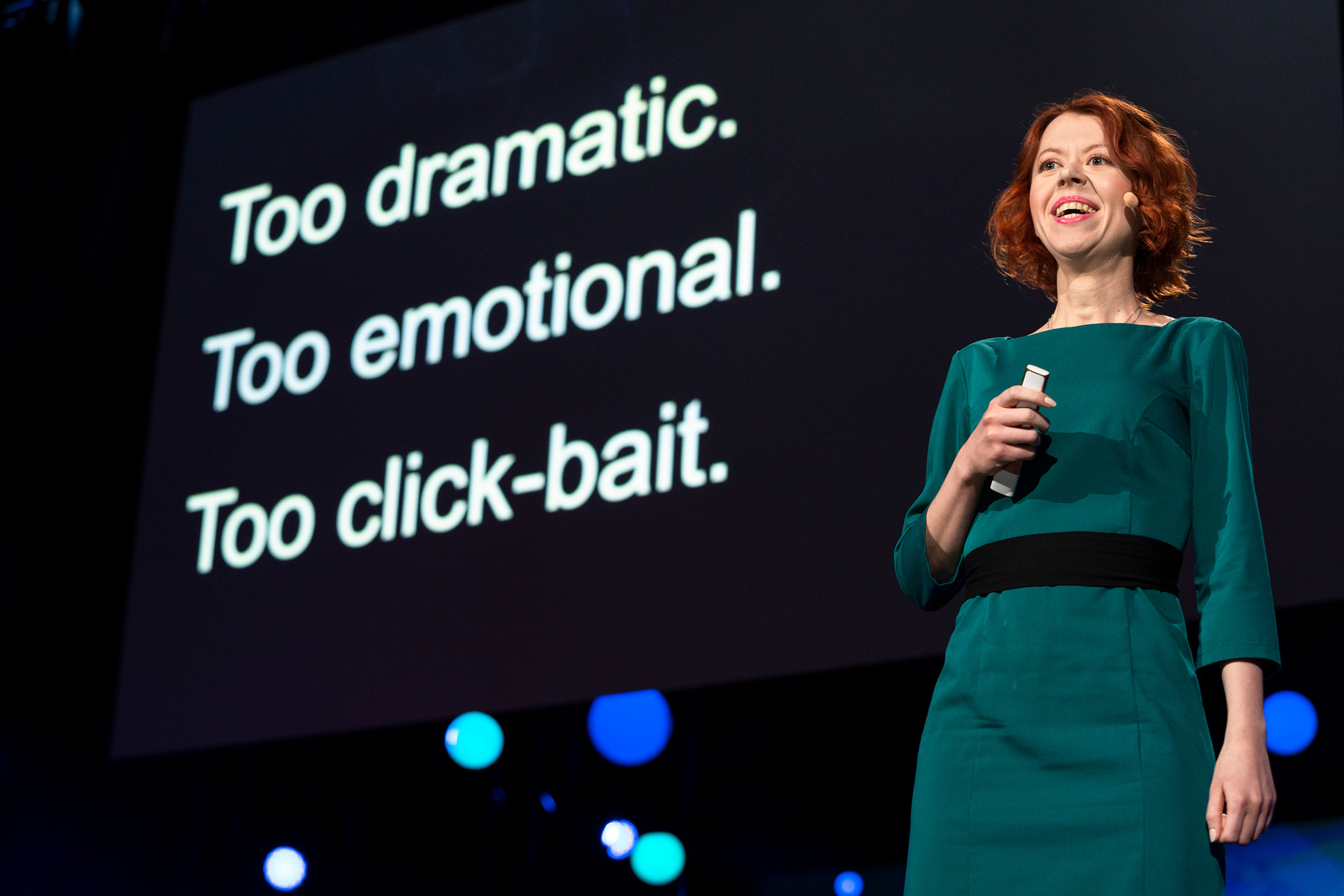
With her project StopFake.org, Olga Yurkova helps train people to avoid sharing viral untruths. She reminds us: Is that viral story in your social media feeds dramatic and emotional? It might just be clickbait, because “the truth is often not that exciting.” Photo: Ryan Lash / TED
Designing for equity and justice. Discrimination, racism, sexism and poverty don’t just happen by chance, says Antionette Carroll, a St. Louis–based social entrepreneur. They tend to be supported by systems that were created by people in order to exclude other people. “Designers such as myself have started to realize that if these different forms of oppression are by design, then they can be redesigned,” Carroll says. After the fatal shooting of Michael Brown by the police in Ferguson, Missouri, in 2014 and the demonstrations and unrest that followed, Carroll established the Creative Reaction Lab to attempt to dismantle systems of inequality. Her nonprofit trains black and Latino youths to be what she calls “equity designers”: individuals who are embedded in the community that they want to change and who use existing resources and good design practices to transform it. For example, they recently explored how the absence of public transportation has affected the lives of lower-income Black community members in St. Louis. Carroll asks, “How do we design a world that provides people with the resources and opportunities needed for them to be their best — and authentic — selves without judgement and hate?” We can’t wait to see what she comes up with.
The human price of cheap migrant labor. Think about any news footage you’ve ever seen of immigration discussions, and then ask yourself: Which of the parties involved is not in the room? “What often is missing in the global debate over refugees, migrants and immigrants — voices of the disenfranchised,” says investigative journalist Yasin Kakande. He chronicled the injustices and inequalities inflicted on the African migrant labor force in the Middle East — until his muckraking writing caused him to be forced out of Dubai and deported. Unable to take the TED2018 stage in Vancouver due to his asylum application status with the US, Kakande delivered an impassioned message via video, urging open discussion between migrants and political leaders. He calls for the drum beat for justice and opportunity to never cease. As he declares, “a hashtag, an op-ed, or an online petition — all admirable for at least acknowledging the problem — nevertheless is still impotent until it is delivered so consistently, so loudly and by such voluminous numbers that the penetrating disinfectant of bright sunshine compels the problem to be confronted and resolved once and for all.”
Signaling the immune system to help with healing. What if you could take a pill that enabled you to heal like Wolverine? Kaitlyn Sadtler, a tissue engineer and immunologist at MIT, is striving to make such super-healing a reality. “Just like vaccines instruct our body to fight disease, we could instead instruct our immune system to build tissues and more quickly heal wounds,” she says. When looking at materials used to regrow muscle, Sadtler and her team found a large number of immune cells at the site of muscle injury. Helper T cells, one particular type of immune cell they discovered, turn out to be critical for wound healing and promoting muscle cell regrowth without nasty complications like scar and fat tissue. Now Sadtler is trying to devise materials or scaffolds that could give our bodies the signals to generate new tissue by changing our immune response. When a scaffold is placed in the body, the body’s immune system modifies the local environment of cells and proteins and affects how and what new cells are generated. As a result, different kind of scaffolds could initiate different immune responses, enabling researchers to conduct what Sadtler calls “an orchestra” of different wound-healing signals. With this kind of technology, she hypothesizes, “in the future, we could see a scar-proof bandaid, moldable muscle fiber, or even a wound-healing vaccine.”
Alleviating the energy burden. Nearly every month, millions of people in the US face an impossible choice: pay for energy, or go without medicine or food. While the average American spends 3 percent of their income on energy, low-income and rural populations may spend as much as 30 percent. With her nonprofit Renewable Energy Transition Initiative (RETI), North Carolina sustainability expert DeAndrea Salvador is working to prevent individuals from having to choose between necessities. RETI is engaging in a multi-pronged strategy to address the home-energy affordability gap in North Carolina: connecting neighborhoods to community solar power; spearheading community-led research and installation programs to make homes more energy-efficient; and working with elected officials to advocate for equitable energy pricing. Salvador is determined yet optimistic: “I know high energy burdens are a tremendous barrier to overcome, but through relationships with communities and technology, we have the paths to overcome them.”
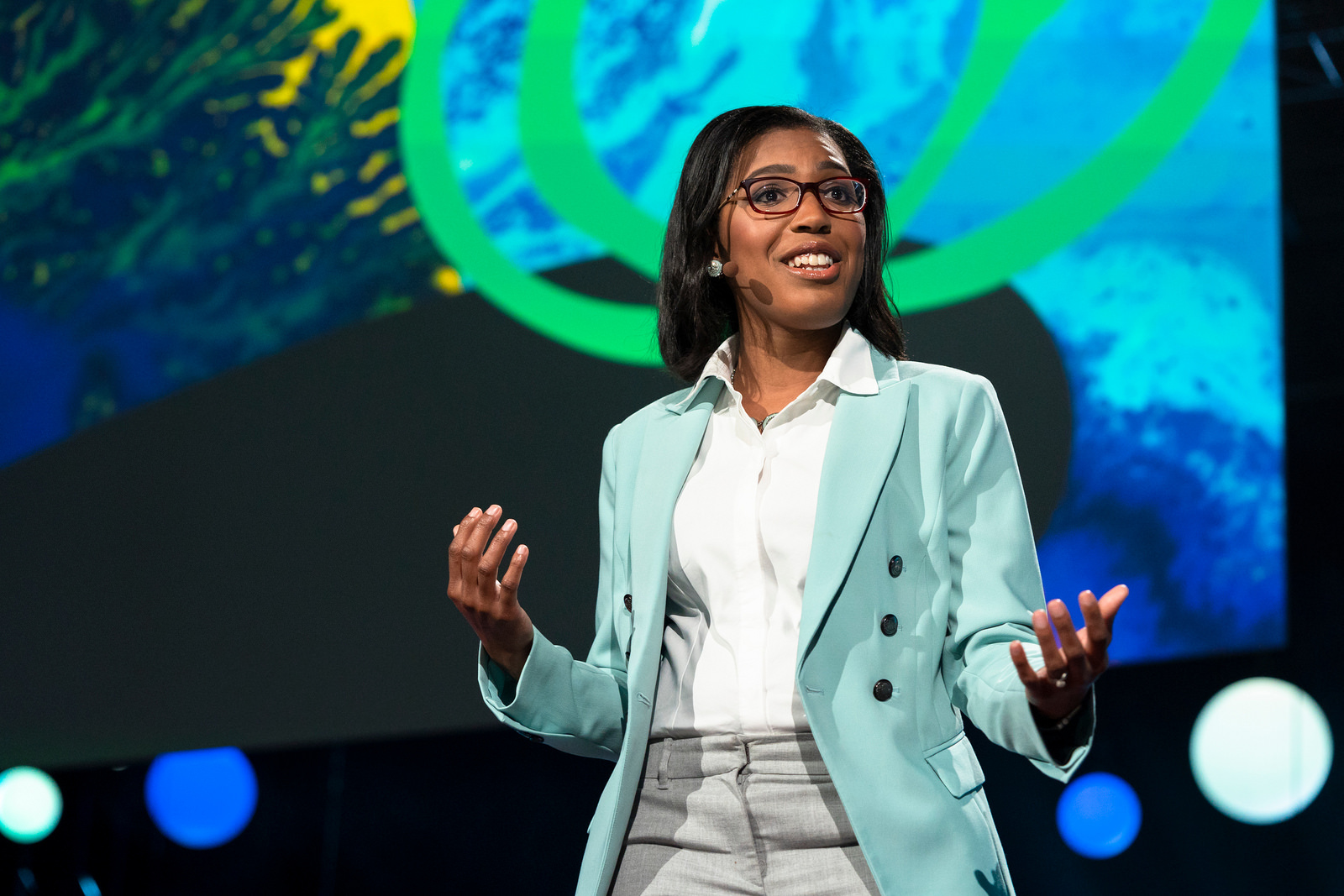
Energy bills can consume up to 30 percent of the budget for a low-income family — forcing them to make impossible choices. DeAndrea Salvador works with families, politicians and researchers to help make energy more affordable and even more sustainable. Photo: Ryan Lash / TED
Humans and glaciers belong together. “Where there are glaciers, there are people, and the two have been influencing each other for the entirety of human history,” says glaciologist M Jackson. “But today, we know so little about people and ice, because in science we have continuously separated the two.” The field of glaciology tends to take an exclusively scientific approach — to focus on measuring and predicting the recession of Earth’s 440,000 glaciers. Jackson, though, advocates for a more inclusive approach; as she says, “If we want to understand what is happening our world today, to us and this planet we live on, as our ice is melting, we need to start looking for the whole picture.” The changing landscape of glaciers is already impacting communities around the world from Iceland to Pakistan. “When we look at people and ice together through different times, and scales, and geographies,” Jackson says, “we start to see immense glacier diversity influencing immense human diversity. We start to get a whole new picture of our history, our adaptability and our future.”
The invisibility of older adults in love. LA-based photojournalist Isadora Kosofsky specializes in deeply immersive work, and onstage she shares the four years she spent documenting the lives of Jeanie, Will and Adina, a senior-citizen threesome, or “throuple.” Her warm photos of this loving relationship among seniors, she tells us, have been off-putting to some people: “Beyond challenging sociocultural norms about the elderly, the trio sheds light on a fear of remoteness,” she says. It’s a feeling we can recognize from another confusing time in our lives: adolescence. No matter our age, we crave purpose and a sense of belonging. Perhaps the discomfort of seeing a senior “throuple” lies in the fact that it serves as a reminder to us: “We may never reach the fantasy we have envisioned for ourselves,” as Kosofsky puts it.
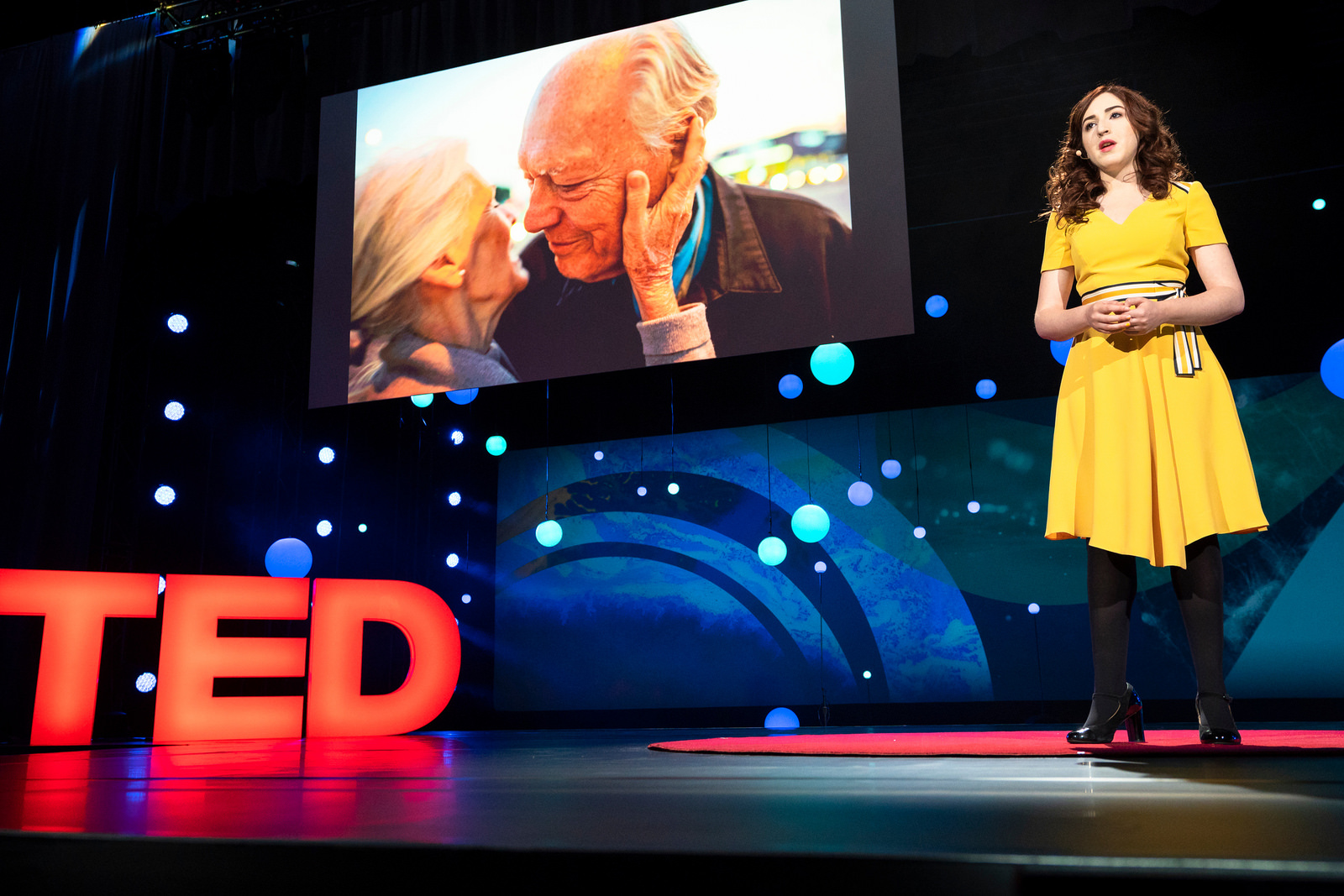
Photographer Isadora Kosofsky spent four years documenting the lives of three older people in a romantic relationship. In her talk, she unpacks why the photos made some people uncomfortable. Photo: Ryan Lash / TED
Bringing transparency to air pollution. How often do you think about the air you’re breathing? Probably not enough, says Paris-based environmental tech entrepreneur Romain Lacombe. Air pollution is an insidious killer, causing as many as 7 million premature deaths around the world a year and costing the world economy up to $5 trillion. In the US, more people die from car exhaust than from car accidents. While urban monitoring stations provide accurate high-level pictures of air quality, pollutant levels change hour by hour and street to street, making the stations not so useful in helping people figure out areas to avoid and which open spaces to play with their kids in. To that end, Lacombe and his startup Plume Labs have developed Flow, a wearable sensor that measures what you’re breathing, from nitrogen dioxide to particulate matter. A companion app makes the information actionable, tracking where and when you’re exposed to pollutants and allowing you to decide how to avoid them. Lacombe’s hopes for the device are not restricted to an individual scale, however. In summer 2017, 100 volunteers used Flow to map air quality in 20 percent of central London. From updated clean-air policies to comprehensive environmental databases, a crowdsourced live map of global air quality opens up endless possibilities. His intent, Lacombe says, is to build not just a device but also a community, one that’s empowered to make healthy choices.
A new vision for humanitarian aid. War-devastated communities around the world are being failed by a broken aid system. Local Syrian organizations deliver 75 percent of the humanitarian work, yet they receive less than 1 percent of the available aid budget, which goes to international NGOs instead. “Local humanitarians are the beacons of light in the darkness of war,” says Syrian-born anesthesiologist Rola Hallam. But they have too little of the equipment and resources they need to save lives. Through her startup CanDo, Hallam is helping first responders in Syria by identifying trusted and effective providers, helping them develop and grow, and connecting them with crowdfunding. One such campaign achieved a global first: the first-ever crowdfunded hospital. Since it opened a year ago, the aptly named Hope Hospital has treated more than 15,000 children. “Local humanitarians have the courage to persist, to dust themselves off from the wreckage and start again, risking their lives to save others,” says Hallam, “and we can match their courage.”
Closing the session is “Blinky Bill” Sellanga. Thanks to his upbeat soundtrack, the attendees exit dancing.